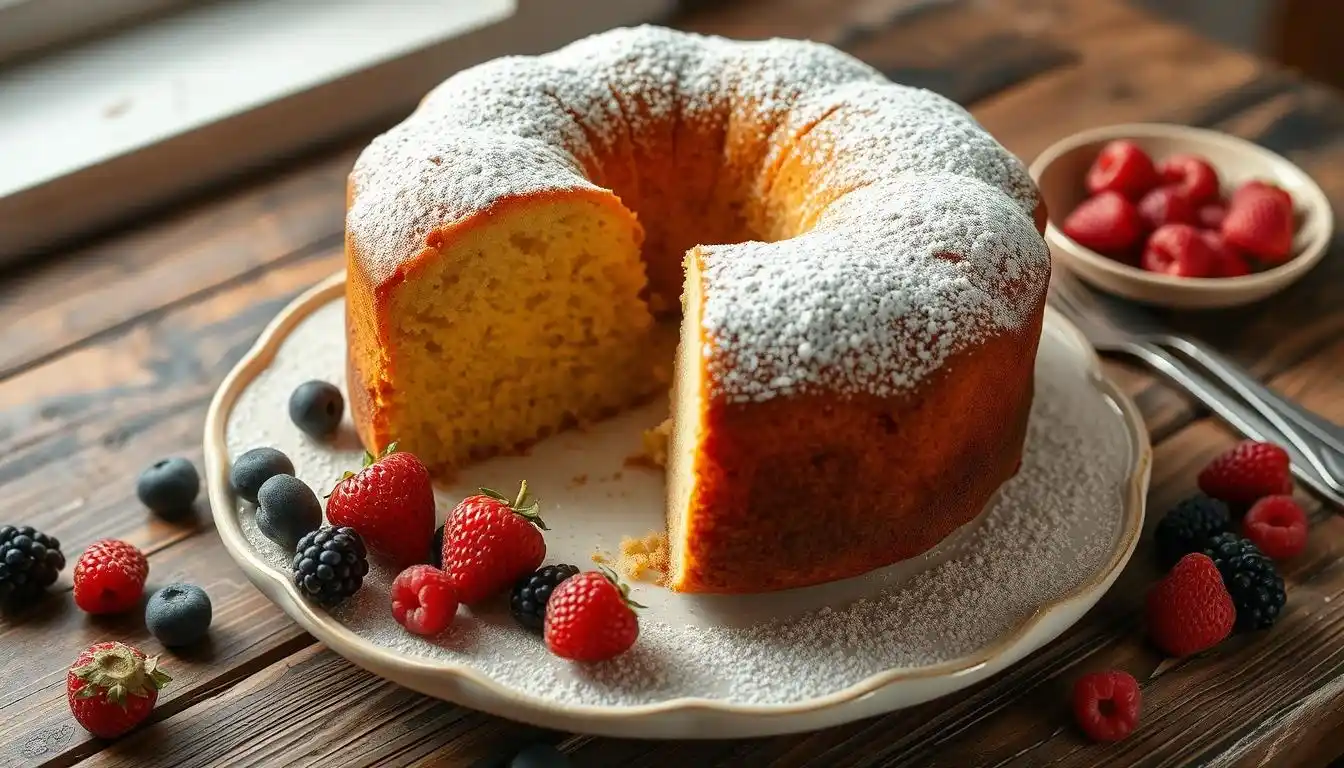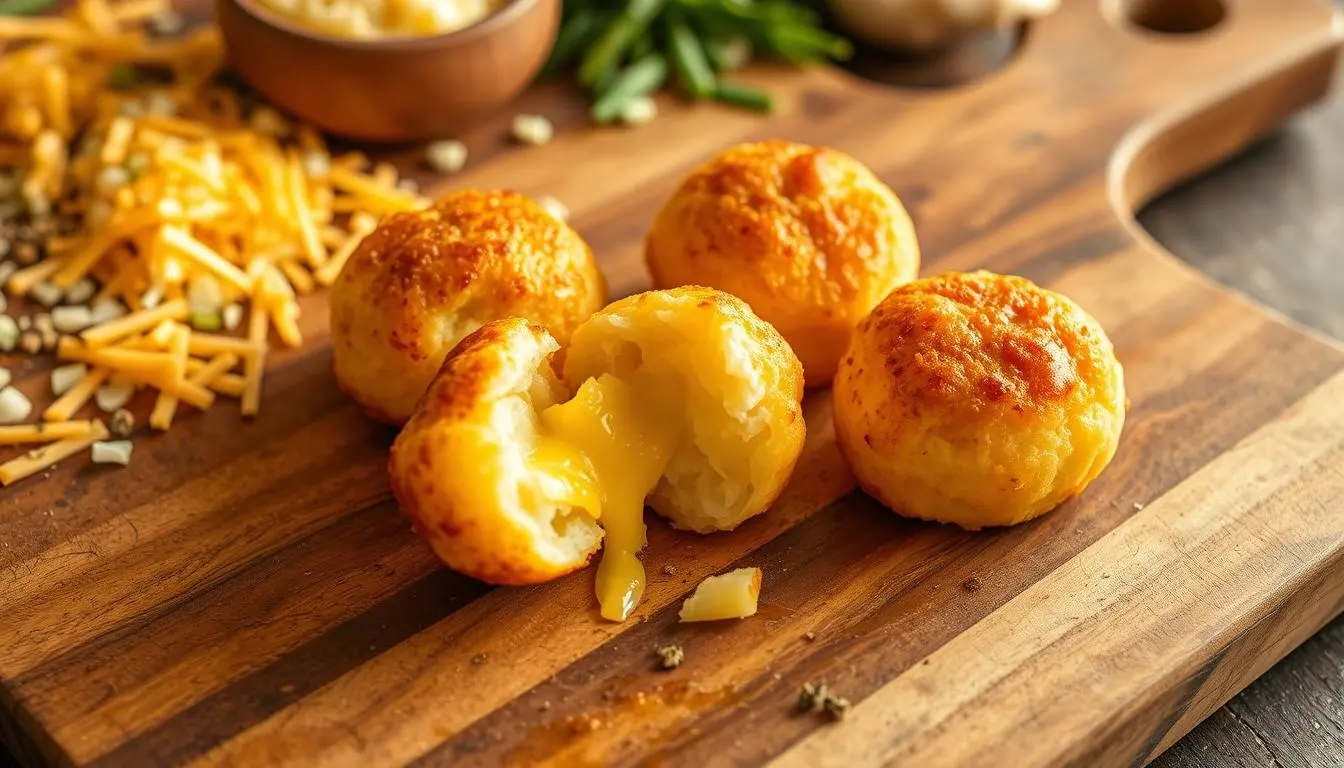Growing up in my grandmother’s kitchen, the smell of fresh old fashioned pound cake was always a sign of comfort and love. Her simple pound cake recipe was a cherished family tradition. It turned ordinary ingredients into a magical dessert that could brighten any day.
The classic old fashioned pound cake recipe is more than just a sweet treat. It’s a culinary connection to generations past. This timeless dessert combines simplicity and elegance, making a pound cake from scratch that feels both nostalgic and deliciously contemporary.
Whether you’re an experienced baker or a kitchen novice, this recipe will guide you. You’ll learn to make a rich, buttery pound cake that melts in your mouth. You’ll see how just a few quality ingredients can create an extraordinary dessert that celebrates traditional baking techniques.
Table of Contents
The History and Heritage of Traditional Pound Cake
Pound cake is a beloved treat with deep roots in European baking. To make a pound cake, you must first understand its long history. This history is filled with centuries of tasty innovation.
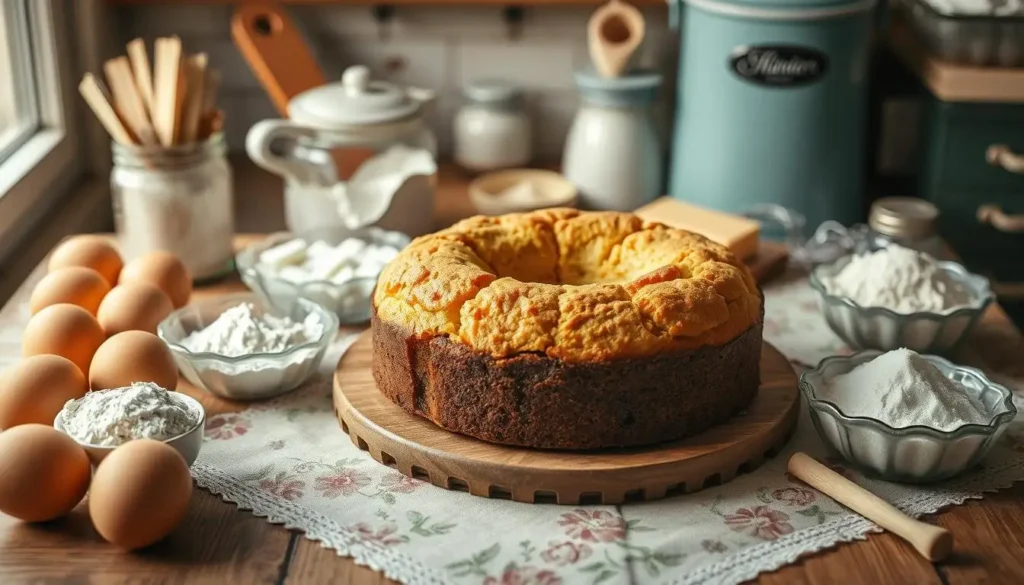
The classic pound cake recipe started in Europe in the 1700s. Bakers made a simple yet amazing dessert with basic measurements. They used:
- One pound of flour
- One pound of butter
- One pound of eggs
- One pound of sugar
European Baking Roots
In early European kitchens, pound cake was a practical dessert. The recipe was easy to remember and make, even for those who couldn’t read well.
American Culinary Evolution
When the cake came to America, bakers made changes. They improved techniques and added new flavors. Today’s pound cake recipes keep the original’s rich taste but offer more variety.
The Origin of the Name
The name “pound cake” comes from its original ingredients. One pound each of main ingredients made a big, filling cake. This name shows the recipe’s humble beginnings in European homes.
“A pound cake tells a story of culinary simplicity and delicious tradition.” – Baking Historians
Essential Ingredients for the Perfect Pound Cake
Making a delicious traditional pound cake begins with the right ingredients. Knowing how each part works together is key. It helps make a moist cake that everyone will love.
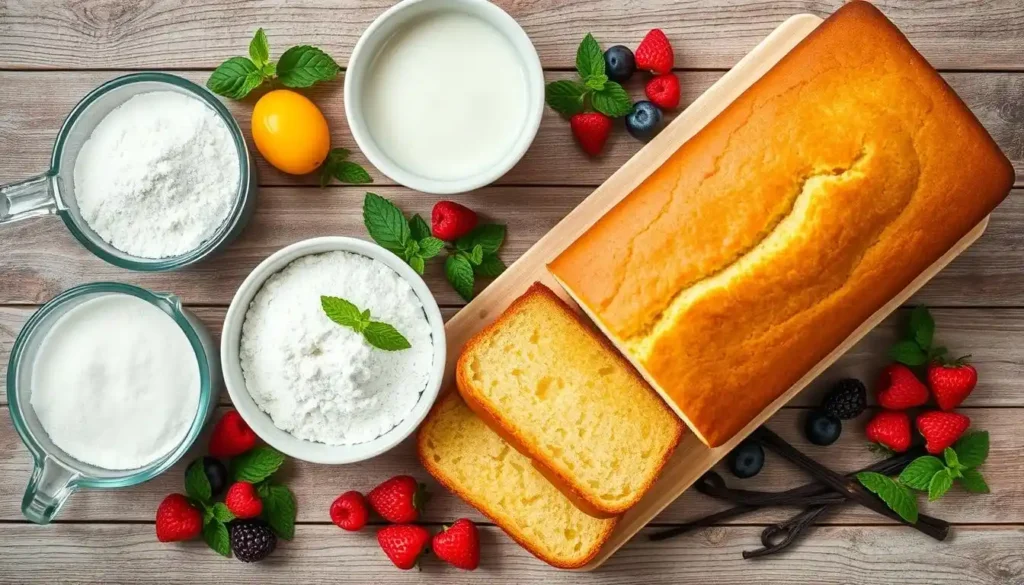
The heart of a great pound cake is its ingredients. Let’s look at the main parts that make a simple mix into a masterpiece:
- Butter: High-quality, unsalted butter makes the cake tender and rich
- Eggs: Fresh, room-temperature eggs add structure and moisture
- Flour: All-purpose flour gives the cake its perfect texture
- Sugar: Granulated white sugar adds sweetness and helps with browning
“The magic of a traditional pound cake is in its simple, pure ingredients” – Baking Experts
Choosing high-quality ingredients can make your homemade pound cake truly special. Each part adds something unique. Together, they create a dessert that’s truly sublime.
| Ingredient | Role in Pound Cake | Best Practice |
|---|---|---|
| Butter | Provides richness and flavor | Use European-style butter with higher fat content |
| Eggs | Adds structure and moisture | Always use room temperature eggs |
| Sugar | Sweetens and helps with browning | Cream thoroughly with butter |
| Flour | Creates cake structure | Sift to remove lumps and ensure smooth texture |
By choosing and preparing your ingredients carefully, you’ll make a moist pound cake. It will be as good as any from a professional bakery.
Kitchen Tools and Equipment You’ll Need
Baking a delicious pound cake from scratch needs the right tools. Vintage dessert recipes like this traditional pound cake require precision and specific equipment for perfect results every time.
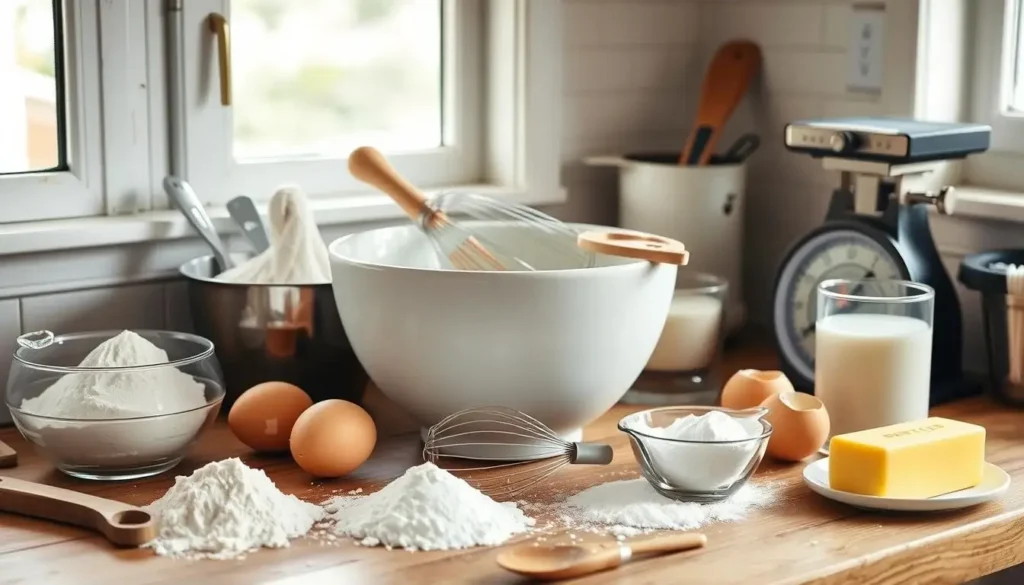
Before baking a pound cake, start by gathering the proper tools. The right equipment can make a big difference between a good and an exceptional dessert.
Essential Mixing and Measuring Tools
- Large mixing bowl (ceramic or stainless steel)
- Electric hand mixer or stand mixer
- Measuring cups (dry and liquid)
- Measuring spoons
- Rubber spatula
- Whisk
Baking Pans and Preparation Equipment
| Pan Type | Recommended Size | Best For |
|---|---|---|
| Loaf Pan | 9×5 inches | Traditional pound cake |
| Bundt Pan | 10-12 cups | Decorative presentation |
| Tube Pan | 9-10 inches | Even baking |
Additional Helpful Utensils
- Cooling rack
- Parchment paper
- Kitchen scale
- Offset spatula
- Pastry brush
Pro tip: Invest in quality baking tools for consistent results when baking pound cake from scratch. Precision is key to creating the perfect vintage dessert.
“The right tools transform good baking into great baking.” – Professional Baker’s Wisdom
Old Fashioned Pound Cake Recipe
Making the best pound cake recipe ever begins with knowing the classic recipes that have pleased many for years. This butter pound cake recipe brings traditional baking magic to your kitchen. It uses simple ingredients and classic techniques.
Ingredients You’ll Need
- 1 cup unsalted butter, softened
- 1 cup granulated sugar
- 4 large eggs, room temperature
- 2 cups all-purpose flour
- 1/2 teaspoon vanilla extract
- 1/4 teaspoon salt
Preparation Steps
- Preheat oven to 325°F
- Cream butter and sugar until light and fluffy
- Add eggs one at a time, mixing thoroughly
- Gradually incorporate flour and salt
- Fold in vanilla extract
Your butter pound cake recipe needs precision. Make sure all ingredients are at room temperature for the best texture and rise. The secret to a perfect pound cake is careful mixing and using high-quality ingredients.
“Baking is love made edible” – Unknown Pastry Chef
Baking Details
| Baking Time | Pan Size | Expected Yield |
|---|---|---|
| 60-75 minutes | 9×5 inch loaf pan | 8-10 servings |
This timeless dessert recipe turns simple ingredients into a rich, buttery masterpiece. It will impress family and friends. Your homemade pound cake will become a cherished family tradition.
Tips for Room Temperature Ingredients
Getting an old fashioned pound cake recipe right starts with the temperature of your ingredients. The right temperature is key for a good texture and rise.
Making a simple pound cake is more than just mixing. The temperature of your ingredients is very important. It helps make the cake tender and delicious.
Why Ingredient Temperature Matters
Ingredients at room temperature mix better and make a batter that’s more even. Cold ingredients can lead to:
- Uneven mixing
- Lumpy batter
- Dense cake texture
Proper Ingredient Preparation
To get ingredients to room temperature fast and safely, try these tips:
- Eggs: Remove from fridge 30 minutes before baking
- Butter: Cut into small cubes and let sit for 15-20 minutes
- Milk: Warm slightly in microwave for 10-15 seconds
“Room temperature ingredients are the secret weapon of professional bakers.” – Pastry Chef Advice
| Ingredient | Room Temperature Time | Quick Method |
|---|---|---|
| Butter | 30-45 minutes | Cut into small pieces |
| Eggs | 30 minutes | Warm in hot water |
| Cream Cheese | 1 hour | Leave on counter |
Pro tip: Never use microwave to completely warm ingredients, as this can alter their chemical structure and impact your pound cake’s texture.
The Art of Proper Mixing Techniques
Learning to mix well is key to making a great pound cake. The right mixing techniques can turn a simple recipe into a masterpiece. This ensures your cake is light and tender, making it truly special.
Here are some important mixing tips:
- Start with room-temperature ingredients
- Cream butter and sugar thoroughly
- Add eggs one at a time
- Fold dry ingredients gently
The creaming method is essential for mixing pound cake. Start by beating softened butter until it’s light and fluffy. Then, add sugar slowly and keep beating until it’s pale and fluffy. This step adds air, making the cake tender.
“Mixing is an art form that transforms simple ingredients into a culinary masterpiece.” – Pastry Chef Advice
Your mixing technique greatly affects the cake’s texture. Overmixing can make the cake tough, while undermixing can prevent ingredients from blending well. Aim for a smooth batter without overworking the ingredients.
| Mixing Stage | Key Technique | Duration |
|---|---|---|
| Butter Creaming | Soft, room temperature butter | 3-5 minutes |
| Sugar Incorporation | Gradual addition | 2-3 minutes |
| Egg Mixing | One at a time | 30 seconds each |
| Flour Folding | Minimal mixing | Until just combined |
Pro tip: Use a stand mixer or hand mixer on medium speed to achieve the perfect consistency. Watch your batter closely and stop mixing as soon as the ingredients are fully incorporated.
Mastering the Creaming Method
Creating a delicious traditional pound cake starts with understanding the creaming method. This technique is the secret to achieving a moist pound cake recipe that delights your taste buds and impresses your guests.
The creaming method might sound complex, but it’s actually a straightforward process. It transforms simple ingredients into a heavenly homemade pound cake. Let’s break down the essential steps to ensure your baking success.
Perfect Butter-Sugar Incorporation
To create the perfect base for your traditional pound cake, follow these key steps:
- Use room temperature butter (softened but not melted)
- Beat butter until smooth and creamy
- Gradually add sugar while continuously beating
- Continue mixing until the mixture becomes light and fluffy
Adding Eggs and Flour Strategically
Proper ingredient incorporation is critical for a smooth, consistent batter:
- Add eggs one at a time, fully incorporating each before adding the next
- Scrape down the sides of the bowl between each addition
- Alternate adding flour and liquid ingredients
- Mix on low speed to prevent overmixing
“The key to a perfect pound cake is patience and technique.” – Baking Professionals
| Mixing Stage | Technique | Duration |
|---|---|---|
| Butter Creaming | Beat until light and fluffy | 3-5 minutes |
| Sugar Incorporation | Gradually add, continue beating | 2-3 minutes |
| Egg Addition | One at a time, full incorporation | 1 minute per egg |
| Flour Mixing | Low speed, alternative additions | 2-3 minutes |
Remember, the creaming method is an art that requires practice. Each step contributes to the texture and flavor of your moist pound cake recipe.
Baking Temperature and Timing Guide
Getting your vintage dessert recipes just right means paying attention to baking details. The perfect temperature and timing turn simple ingredients into a treat that’s sure to please.
Knowing your oven’s quirks is key when baking a pound cake. Most recipes suggest keeping the oven between 325°F and 350°F.
- Preheat your oven for at least 15-20 minutes
- Use an oven thermometer to verify the accurate temperature
- Place the cake in the center rack for even heating
Baking times can change based on pan size and recipe. Here’s a guide to help you get it right:
| Pan Size | Baking Temperature | Estimated Baking Time |
|---|---|---|
| 9×5 inch loaf pan | 350°F | 60-75 minutes |
| 8×4 inch loaf pan | 325°F | 50-65 minutes |
| Bundt pan | 325°F | 65-80 minutes |
“Patience is the secret ingredient in baking the perfect pound cake.” – Vintage Baking Wisdom
Every oven is different. Start checking your cake 10 minutes before the suggested time to avoid over-browning. A golden-brown crust and a toothpick that comes out clean mean it’s done.
How to Test for Doneness
Getting the best pound cake recipe right means knowing when it’s done. It’s all about finding the perfect moment to take it out of the oven. This can make or break your butter pound cake.
Baking a pound cake needs precision. The difference between a great cake and a bad one is knowing when it’s ready. It’s all about the signs.
Visual Cues to Check Cake Doneness
- Look for a golden-brown color across the top surface
- Notice slight pulling away from the pan’s sides
- Check for a uniform, even surface without wet-looking spots
- Observe a gentle crack along the top, indicating proper rising
Reliable Testing Methods
- Toothpick Test: Insert a clean toothpick into the cake’s center
- If it comes out clean or with minimal crumbs, the cake is done
- Wet batter on the toothpick means more baking time is needed
- Gentle Surface Press
- Lightly touch the cake’s center
- It should spring back immediately when fully baked
“Patience and observation are key to baking the perfect pound cake.” – Professional Baker
Every oven is different. Trust your senses and these methods to make a moist, tender, and delicious pound cake.
Cooling and Storage Recommendations
Perfecting your old-fashioned pound cake recipe doesn’t end when you pull it from the oven. The cooling and storage process is key to keeping the cake’s texture and flavor right. Your homemade pound cake needs careful handling to stay delicious.
After baking your simple pound cake, follow these essential cooling steps:
- Remove the cake from the oven and let it sit in the pan for 10-15 minutes
- Gently run a knife around the edges to loosen the cake
- Transfer to a wire cooling rack to cool completely
Storage is key to keeping your pound cake fresh and moist. Temperature and container choice matter significantly.
| Storage Method | Duration | Best Practices |
|---|---|---|
| Room Temperature | 3-4 days | Use an airtight container |
| Refrigerator | Up to 1 week | Wrap tightly in plastic wrap |
| Freezer | Up to 3 months | Wrap in plastic, then foil |
“A well-stored pound cake is a baker’s pride and joy!” – Baking Enthuasiast
When freezing your pound cake, let it cool completely before wrapping. Thaw at room temperature for best results. This way, your homemade treat stays as delicious as the moment it was baked.
Common Troubleshooting Tips
Making the perfect pound cake takes skill and practice. Even experienced bakers face challenges. Knowing how to fix these issues helps you become more confident in your baking.
When baking a pound cake, you might run into problems that affect its texture and look. Let’s look at some common issues and how to solve them.
Texture Troubles: Identifying and Resolving Issues
- Dense Cake: Often caused by overmixing or incorrect ingredient measurements
- Solution: Gently fold ingredients and measure precisely
- Dry Texture: Results from overbaking or too much flour
- Solution: Check oven temperature and use accurate measuring tools
Baking Problem Solutions
| Problem | Potential Cause | Fix |
|---|---|---|
| Cracked Surface | Incorrect oven temperature | Lower temperature, use center rack |
| Sunken Center | Undermixed batter | Cream butter and sugar thoroughly |
| Uneven Baking | Old or uneven oven | Rotate the pan midway use oven thermometer |
“Baking is a science, but pound cake is an art of patience and precision.” – Pastry Chef
Mastering pound cake recipes from scratch requires understanding these techniques. With practice and attention to detail, you’ll get better. Soon, you’ll make a perfect pound cake every time.
Serving Suggestions and Variations
Your traditional pound cake is a blank canvas for creativity. A moist pound cake recipe opens up endless possibilities. You can create delightful presentations and flavor transformations that will wow your guests and satisfy your sweet tooth.
Classic serving suggestions can make your homemade pound cake truly spectacular:
- Fresh Berry Topping: Macerate strawberries, raspberries, or blueberries with a touch of sugar
- Whipped Cream Garnish: Create billowy peaks of freshly whipped cream
- Citrus Glazes: Drizzle lemon or orange-infused glazes for bright flavor
- Chocolate Drizzle: Enhance with rich melted chocolate
Flavor variations can turn your traditional pound cake into an exciting culinary experience:
| Flavor Variation | Key Ingredients | Taste Profile |
|---|---|---|
| Lemon Pound Cake | Lemon zest, fresh lemon juice | Bright, tangy |
| Almond Pound Cake | Almond extract, sliced almonds | Nutty, delicate |
| Chocolate Marble | Cocoa powder, chocolate swirls | Rich, decadent |
Want to make your pound cake truly special? Try adding unexpected additions like lavender, rosemary, or a splash of bourbon. This will create a unique dessert that shows off your personal style.
“A great pound cake is like a blank slate – limited only by your imagination!” – Pastry Chef Emma Richardson
Seasonal Garnishes and Toppings
Make your vintage dessert recipes pop with creative garnishes. These can turn a simple pound cake into a showstopper. The right toppings make your classic dessert a stunning centerpiece for any event.
Spring is a great time to add fresh touches to your pound cake:
- Strawberry compote with edible flowers
- Lemon zest and fresh mint sprigs
- Lavender-infused whipped cream
Summer brings bright garnishing options:
- Fresh berry medley
- Grilled peach slices
- Coconut cream drizzle
Autumn and winter call for warm toppings:
- Caramelized apple chunks
- Spiced maple glaze
- Candied pecans
“A beautifully garnished pound cake is like a canvas waiting to showcase seasonal flavors.” – Pastry Chef Emma Richardson
Your garnishes should enhance the cake’s texture and add to its beauty. They should also bring new flavors to the table. Try out different combinations to find your unique style.
Conclusion
Learning to make butter pound cake is more than just following a recipe. It’s about starting a tradition that brings families together. You’ve discovered the secret to making this dessert special.
The best pound cake recipe is about more than just following steps. It’s about the love and care you put into every step. When you mix, fold, and bake, you’re part of a long tradition. Your hard work makes the cake truly special.
Every pound cake has its own story. Whether it’s for a family event or a quiet moment, it’s a chance to be creative. Let your passion for baking show in every detail, making each bite unforgettable.
Now, you’re ready to create many more special moments in the kitchen. Bake with confidence, share your creations, and enjoy the fruits of your labor.
FAQ
What makes a traditional pound cake different from other cakes?
A traditional pound cake uses one pound each of butter, sugar, eggs, and flour. This recipe makes a dense, rich cake. It has a buttery flavor and a tighter crumb than lighter cakes.
Can I make pound cake without a stand mixer?
Absolutely! You can use a hand mixer or mix by hand with a wooden spoon. The key is to cream the butter and sugar well. This ensures a smooth batter.
How do I prevent my pound cake from becoming dry?
To keep your cake moist, use room-temperature ingredients. Don’t overmix the batter. And avoid overbaking. Use a toothpick test to check for doneness.
Can I add flavors to my traditional pound cake?
Yes! You can add lemon zest, vanilla extract, or almond extract. Just be careful not to add too much liquid. This could change the cake’s texture.
How long will a homemade pound cake stay fresh?
A homemade pound cake stays fresh for 3-4 days in an airtight container. You can refrigerate it for up to a week. Or freeze it for 2-3 months.
What’s the best pan to use for pound cake?
A classic loaf pan or a traditional tube pan is best. A 9×5-inch loaf pan is common. It ensures even baking and the classic shape.
Why are my room-temperature ingredients important?
Room-temperature ingredients blend more easily. This creates a smoother batter. Cold ingredients can cause the batter to curdle, affecting the cake’s texture.
Can I make a pound cake gluten-free?
Yes, you can use a gluten-free flour blend. Look for blends with xanthan gum. Or add it separately to help with structure and texture.
How do I know when my pound cake is done baking?
Check for golden brown color, slight pull from the pan, and moist crumbs with a toothpick. The internal temperature should be 200-210°F.
Can I make pound cake ahead of time?
Definitely! Pound cake is great to make ahead. Bake it 1-2 days before, wrap it tightly, and store it at room temperature. Some say the flavor gets better after a day.
What did you think about this recipe?
There are no reviews yet. Be the first one to write one.
Yummy Potato Cheese Balls

Growing up, those crispy potato cheese balls made family dinners special. The first time I had one, the outside was … Read more
How to Make the Perfect Berries and Cream

Every summer evening, I remember sitting on my grandmother’s porch. We’d watch her make a magical berry and cream recipe. It … Read more

